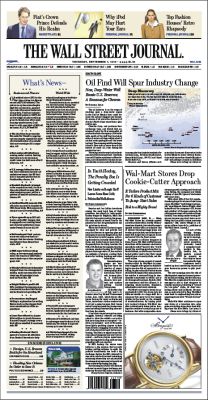Wall Street Journal stretches online
The notable American newspaper Wall Street Journal was the first to radically change the format of the paper publication, making it secondary to the site. And the pages will be made narrow and long, like web pages.

Changing the paper size will occur on January 2. The first issue of the new sample will be handed out for free. And the site, which is basically paid - there for 800 thousand paying subscribers - will be open for free that day. The main idea of the change: the site and paper will work together. The site will provide current news coverage, and the newspaper will talk about the significance of events, only briefly reminding you of yesterday’s main topics. The exclusive share in the newspaper will grow from 50% to 80%, additional and expanded sections will appear for this: plans for today, an “informed reader”, “letters to the editor”, twice as much culture, etc.
On the site of the publisher Dow Jones, which owns WSJ, you can already read about the upcoming changes and look at the title page in a new format: www.dowjones.com/newjournal.htm
In the accompanying releases and comments, a lot of the right things are written:
* paper focus on interpretations , insight and ideas;
* Changes will be on every page: a new digital font, an abundance of infographics, easier typography, a more prominent style of headings, improved labeling of topics and headings (labeling?), insets with summary information (summary boxes);
* Advertisers will be offered more sophisticated inclusion formats;
* the format will change, but credibility, substance, and essentiality will remain (this is a marketing statement, but important for positioning);
* such a change is a risk and an investment in the future, but the current financial condition is so successful that now is just the moment to allow it;
* The newspaper will be long and narrow. A format that, according to the editorial staff, is easier to keep and wear. The proportions are 1: 2 (thephrase “The print Journal will convert to a 48-inch web width” - what does it mean 1.2 meters wide? - before cutting, see comments) is not very clear . Acrobat shows 29.4 × 56.7 cm. This is almost the same height as the “regular” newspaper, and a third narrower. It’s like “ Friday ” (“Vedomosti” application), whose format is D2 (not available in the ISO216 standard , where A4 is defined).
WSJ publisher L. Gordon Krovits poses a crucial question:
It would seem a dream - a large newspaper recognized the Internet and completely changed its format so as not to compete with its website, but to find a symbiosis.
We just look at the pdf of the first page and are surprised: it is not clear where the beauty of typography and emphasis are: flat takeaways, all yesterday's news in one big garbage dump. It looks unattractive. However, do not trust the impression of screen copies: on paper everything will be perceived differently.

Changing the paper size will occur on January 2. The first issue of the new sample will be handed out for free. And the site, which is basically paid - there for 800 thousand paying subscribers - will be open for free that day. The main idea of the change: the site and paper will work together. The site will provide current news coverage, and the newspaper will talk about the significance of events, only briefly reminding you of yesterday’s main topics. The exclusive share in the newspaper will grow from 50% to 80%, additional and expanded sections will appear for this: plans for today, an “informed reader”, “letters to the editor”, twice as much culture, etc.
On the site of the publisher Dow Jones, which owns WSJ, you can already read about the upcoming changes and look at the title page in a new format: www.dowjones.com/newjournal.htm
In the accompanying releases and comments, a lot of the right things are written:
* paper focus on interpretations , insight and ideas;
* Changes will be on every page: a new digital font, an abundance of infographics, easier typography, a more prominent style of headings, improved labeling of topics and headings (labeling?), insets with summary information (summary boxes);
* Advertisers will be offered more sophisticated inclusion formats;
* the format will change, but credibility, substance, and essentiality will remain (this is a marketing statement, but important for positioning);
* such a change is a risk and an investment in the future, but the current financial condition is so successful that now is just the moment to allow it;
* The newspaper will be long and narrow. A format that, according to the editorial staff, is easier to keep and wear. The proportions are 1: 2 (the
WSJ publisher L. Gordon Krovits poses a crucial question:
“We are launching a new type of newspaper - a publication that goes much further than the events of yesterday and focuses on what this news means. And through changes to the content, navigation and integration of print and online, we will make WSJ even more significant. ”
It would seem a dream - a large newspaper recognized the Internet and completely changed its format so as not to compete with its website, but to find a symbiosis.
We just look at the pdf of the first page and are surprised: it is not clear where the beauty of typography and emphasis are: flat takeaways, all yesterday's news in one big garbage dump. It looks unattractive. However, do not trust the impression of screen copies: on paper everything will be perceived differently.
